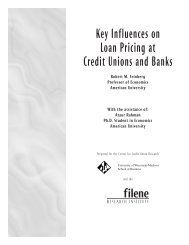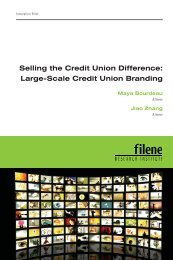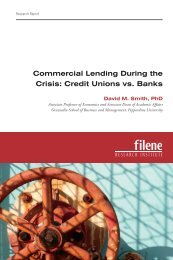Credit Union and Cooperative Patronage Refunds - Filene ...
Credit Union and Cooperative Patronage Refunds - Filene ...
Credit Union and Cooperative Patronage Refunds - Filene ...
Create successful ePaper yourself
Turn your PDF publications into a flip-book with our unique Google optimized e-Paper software.
<strong>and</strong> the consumer is money ahead over an IOF even if none of the<br />
balance of up to 80% of the allocation is ever redeemed to the consumer<br />
member.<br />
The business member of a co-op that is taxed under Subchapter T<br />
pays income tax on the entire distribution of cash plus allocated<br />
equity. Assume that each business member pays tax at a marginal<br />
rate of 35%. For every dollar of income that is reported to on<br />
1099-PATR to the IRS, the business pays income tax of 35 cents.<br />
If the co-op pays only a 20% cash refund, the business member is<br />
in a deficit position of 15 cents for each dollar of patronage income<br />
that is allocated to the member. Hence, business members are most<br />
likely to complain to the board of directors <strong>and</strong> management that the<br />
co-op is not paying enough cash <strong>and</strong>/or redeeming equity quickly<br />
enough to justify a co-op membership.<br />
Allocating less than all of the patronage income <strong>and</strong> paying income<br />
tax on the balance is not the only strategy that a co-op might adopt<br />
to help the co-op manage the amount of capital that is available to it.<br />
A Subchapter T co-op may also consider paying business members a<br />
higher cash patronage refund than consumer members to differentiate<br />
between consumers <strong>and</strong> businesses. In addition, a Subchapter T<br />
co-op could also distinguish between consumers <strong>and</strong> businesses by<br />
redeeming the allocated equity of businesses more quickly than it<br />
redeems the allocated equity of consumers.<br />
At the end of the day, any Subchapter T co-op’s board of directors<br />
<strong>and</strong> management must evaluate <strong>and</strong> determine how much capital<br />
its co-op can devote to redemptions of allocated equity. That determination<br />
will depend on the co-op’s need for capital. Its growth. Its<br />
potential. Its risk of sustaining losses. Its ability to attract outside<br />
capital. Its ability to generate earnings.<br />
The important thing for a Subchapter T co-op is to arrive at a<br />
redemption program that makes sense to the co-op <strong>and</strong> its members.<br />
A redemption program should be consistent with the varying<br />
tax positions of its members. The program should be sustainable<br />
but also challenge the co-op <strong>and</strong> its members. The program should<br />
reward patronage more than it rewards ownership. And finally, the<br />
program should be capable of being communicated to members in a<br />
way that makes sense to members.<br />
Examining the Tax Exemption<br />
In 1983, the GAO suggested that Congress consider an evolution<br />
of rural electric cooperatives from 501(c)(12) to Subchapter T, but<br />
Congress did not act on the GAO’s suggestion.<br />
In its 1983 report, the GAO contended that the tax exemption was<br />
difficult to administer <strong>and</strong> that industrial <strong>and</strong> commercial members<br />
55








